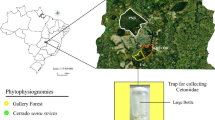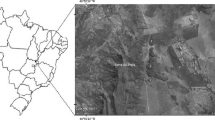Abstract
The potential contribution of palm plantations to the conservation of forest-dwelling Cetoniinae (Coleoptera, Scarabaeidae) is assessed in southern Benin. Sample plots of 10 aerial traps per habitat type were set in two sites containing a forest patch, a palm plantation and some agricultural land. Overall, 2,217 individuals belonging to 31 species were collected. Typical species of each habitat were identified with the IndVal method (Dufrêne and Legendre 1997). Species were categorized into three habitat-groups: forest specialists (11 species), farmland and open habitat specialists (9 species) and ubiquitous, generalist species found in all habitats (5 species). Only six species were too rare for assessing habitat preference. Palm plantations host a low density of Cetoniinae with no unique species. However, species composition reveals that they are used by forest specialist species that avoid open habitats like farmlands, therefore providing structural connectivity. Cetoniine flower beetles have potential as an indicator group, which can be used in multi-taxa approaches for habitat assessments in Africa. Using species-level metrics, their response to habitat change is clear, including the response of common species. This method is selective, cost-effective in time and materials, and species identification is rather straightforward.







Similar content being viewed by others
References
Akoegninou A (1984) Contribution à l’étude botanique des îlots de forêts denses humides semi-décidues en République du Bénin. Dissertation, Université de Bordeaux III
Akoudjin M, Cesar J, Kombassere A, Bouyer J (2011) Spatio-temporal variability of fruit feeding insects used as ecological indicators in West Africa. Bois For Trop 308(2):21–32
Allemand R, Aberlenc HP (1991) Une méthode efficace d’échantillonnage de l’entomofaune des frondaisons: le piège attractif aérien. Bull Soc ent Suisse 64:293–305
Anhuf D (1994) Zeitlicher Vegetations- und Klimawandel in der Côte d’Ivoire. Erdwissenschaftliche Forschung 30:7–299
Basset Y, Missa O, Alonso A, Miller SE, Curletti G, De Meyer M, Eardley C, Lewis OT, Mansell MW, Novotny V, Wagner T (2008a) Faunal turnover of arthropod assemblages along a wide gradient of disturbance in Gabon. Afr Entomol 16:47–59
Basset Y, Missa O, Alonso AA, Miller SE, Curletti G, De Meyer M, Eardley C, Lewis OT, Mansell MW, Novotny V, Wagner T (2008b) Choice of metrics for studying arthropods responses to habitat disturbances: one example from Gabon. Insect Conserv Diver 1:55–66
Bloom S (1981) Similarity indices in community studies: potential pitfalls. Mar Ecol 5:125–128
Bouyer J, Youssoufou S, Samandoulgou Y, Cesar J, Guerrini L, Kabore-Zoungrana C, Dulieu D (2007) Identification of ecological indicators for monitoring ecosystem health in the trans-boundary W Regional park: a pilot study. Biol Conserv 138:73–88
Bried JT, Herman BD, Ervin GN (2007) Umbrella potential of plants and dragonflies for wetlands conservation: a quantitative case study using the umbrella index. J Appl Ecol 44:833–842
Brown KSJ (1991) Conservation of insects and their habitats: insects as indicators. In: Collins NM, Thomas JA (eds) The conservation of insects and their habitats. Academic Press, London, pp 350–404
Brustel H (2004) Coléoptères saproxyliques et valeur biologique des forêts françaises. Office National des Forêts, Les dossiers forestiers no 13, Paris
Caro TM (2010) Conservation by proxy: Indicator, umbrella, keystone, flagship, and other surrogate species. Island Press, Washington, DC
Clavel J, Julliard R, Devictor V (2010) Worldwide decline of specialist species: toward a global functional homogenization? Front Ecol Environ 9:222–228
Costa CB, Ribeiro SP, Castro PTA (2010) Ants as bioindicators of natural succession in savanna and riparian vegetation impacted by dredging in the Jequitinhonha river basin, Brazil. Restor Ecol 18:148–157
Daily GC, Ehrlich PR (1995) Preservation of biodiversity in small rain forest patches: rapid evaluation using butterfly trapping. Biodivers Conserv 4:35–55
Davis ALV (1993) Alpha diversity patterns of dung beetle assemblages (Coleoptera: Scarabaeidae, Hydrophilidae, Histeridae, Staphylinidae) in the winter rainfall region of South Africa. Afr Entomol 1:67–80
Dent DH, Wright SJ (2009) The future of tropical species in secondary forests: a quantitative review. Biol Conserv 14:2833–2843
Devictor V, Robert A (2009) Measuring community responses to large-scale disturbance in conservation biogeography. Diversity Distrib 15:122–130
Doerr VAJ, Barett T, Doerr ED (2011) Connectivity, dispersal behaviour and conservation under climate change: a response to Hodgson et al. J Appl Ecol 48:143–147
Dufrêne M, Legendre P (1997) Species assemblages and indicator species: the need for a flexible asymmetrical approach. Ecol Monogr 67:345–366
Elbers JP, Bossart JL (2009) Occurrences of forest butterflies in the farm bush savannah outside a forest reserve in Ghana, West Africa. Int J Trop Insect Sci 29(3):141–150
Fermon H, Waltert M, Larsen TB, Dall’asta U, Mühlenberg M (2000) Effects of forest management on diversity and abundance of fruit-feeding nymphalid butterflies in south-eastern Côte d’Ivoire. J Insect Conserv 4:173–189
Fermon H, Schulze CH, Waltert M, Meuhlenberg M (2001) The butterfly fauna of the Noyau Central, Lama Forest (Republic of Benin), with notes on its ecological composition and geographic distribution. Afr Entomol 9:177–185
Fermon H, Waltert M, Mühlenberg M (2003) Movement and vertical stratification of fruit-feeding butterflies in a managed West African rainforest. J Insect Conserv 7:7–19
Gardner TA, Barlow J, Araujo IS, Avila-Pires TC, Bonaldo AB, Costa JE, Esposito MC, Ferreira LV, Hawes J, Hernandez M, Hoogmoed M, Leite R, Lo-Man-Hung N, Malcom JR, Martins MB, Mestre L, Miranda-Santos R, Overal W, Parry L, Peters S, Ribeiro-Junior MA, da Silva M, da Silva Motta C, Peres CA (2008) The cost-effectiveness of biodiversity surveys in tropical forests. Ecol Lett 11:139–150
Gardner TA, Barlow J, Chazdon R, Ewers RM, Harvey CA, Peres CA, Sodhi NS (2009) Prospects for tropical forest biodiversity in a human-modified world. Ecol Lett 12(6):561–582
Gollan JR, de Bruyn LL, Reid N, Smith D, Wilkie L (2011) Can ants be used as ecological indicators of restoration progress in dynamic environments? A case study in a revegeted riparian zone. Ecol Indic 11:1517–1525
Grant PBC, Samways MJ (2011) Micro-hotspot determination and buffer zone value for Odonata in a globally significant biosphere reserve. Biol Conserv 144:772–781
Hammer Ø, Harper DAT, Ryan PD (2001) PAST: palaeontological software for education and data analysis. Palaeontologia electronica 4(1):9. Version 1.90 (April 2009). Available online: http://folk.uio.no/ohammer/past/
Hanski H, Cambefort Y (eds) (1991) Dung beetles ecology. Princeton University Press, Princeton, NJ
Holloway JD, Barlow HS (1992) Potential for loss of biodiversity in Malaysia, illustrated by the moth fauna. In: Kadir AA, Barlow HS (eds) Pest management and the environment in 2000. CAB International and Agricultural Institute of Malaysia. pp 293–311
Holm E, Marais E (1992) Fruit chafer of Southern Africa. Ekogilde, Hartebeespoort, South Africa
Janzen D (1984) Two ways to be a tropical big moth: Santa Rosa Saturniids and Sphingids. Oxf Surv Evol Biol 1:85–140
Jerath ML, Unny KL (1965) Larvae of six genera of Cetoniinae from Eastern Nigeria (Coleoptera: Scarabaeidae). Coleopt Bull 19(2):59–64
Juhé-Beaulaton D (1998) La palmeraie du Sud Bénin avant la colonisation: essai d’analyse historique. In: Chastanet M (ed) Plantes et paysages d’Afrique. Une histoire à explorer. Karthala et C.R.A, Paris, pp 327–352
Kokou K, Sokpon N (2006) Les forêts sacrées du couloir du Dahomey. Bois For Trop 288(2):15–23
Kokou K, Caballe G, Akpagana K, Batawila K (1999) Les îlots forestiers du Sud-Togo: dynamique et relation avec les végétations périphériques. Rev Ecol 54:301–314
Lachat T (2004) The impact of forest management on saproxylic beetles and other arthropods in a semi-deciduous forest in Southern Benin. Dissertation, Philosophisch-Naturwissenschaftlichen Fakultät der Universität Basel
Lawton JH, Bignell DE, Bolton B et al (1998) Biodiversity inventories, indicator taxa and effects of habitat modification in tropical forest. Nature 391:72–76
Le Gall P (2010) Affinités biogéographiques des Insectes du “Dahomey gap” : présence d’une population de Goliathus goliatus Linné, 1771, au Bénin (Coleoptera, Scarabaeidae, Cetoniinae). Bull Soc Ent Fr 115(1):17–21
Le Gall P, CJRD-CIAH, Kamgang R (2011) Les Cétoines du Mbam-Minkom, un site menacé par l’urbanisation de la région de Yaoundé (Cameroun) (Coleoptera, Scarabaeoidea, Cetoniidae). Le Coléoptériste 14(3):171–180
Leal IR, Bieber AGD, Tabarelli M, Andersen AN (2010) Biodiversity surrogacy: indicator taxa as predictors of total species richness in Brazilian Atlantic forest and Caatinga. Biodivers Conserv 19:3347–3360
Lovell S, Hamer M, Slotow R, Herber D (2007) Assessment of congruency across invertebrate taxa and taxonomic levels to identify potential surrogates. Biol Conserv 139:113–125
Lovell S, Hamer M, Slotow R, Herbert D (2010) Assessment of sampling approaches for a multi-taxa invertebrate survey in a South African savanna-mosaic ecosystem. Aust Ecol 35:357–370
Margules CR, Pressey RL, Williams PH (2002) Representing biodiversity: data and procedures for identifying priority areas for conservation. J Biosci 27:309–326
Mawdsley JR, Harrison J du G, Sithole H, Mawdsley JL (2011) Landscape-scale surveys reveal patterns of floral visitation by species of Scarabaeidae (Coleoptera) in the Kruger National Park, South Africa. J Nat Hist 45(21–22):1257–1273. http://dx.doi.org/10.1080/00222933.2011.552806
McGeoch MA (1998) The selection, testing and application of terrestrial insects as bioindicators. Biol Rev Camb Philos Soc 73:181–201
Mouillot D, Culioli JM, Do Chi T (2002) Indicator species analysis as a test of non-random distribution of species in the context of marine protected areas. Environ Conserv 29:385–390
Nichols E, Gardner TA, Peres CA et al (2009) Co-declining mammals and dung beetles: an impending ecological cascade. Oikos 118:481–487
Reyers B, Wessels KJ, van Jaarsveld AS (2002) An assessment of biodiversity surrogacy options in the Limpopo Province of South Africa. Afr Zool 37:185–195
Rossi J-P (2011) Extrapolation and biodiversity indicators: handle with caution! Ecol Indic 11:1490–1491
Sakai K, Nagai S (1998) The Cetoniine beetles of the world. Mushi-Sha’s Iconographic series of Insects 3, In: Fujita H (ed) Japan
Sato M, Riddiford N (2008) A preliminary study of the Odonata of S’Albufera Natural Park, Mallorca: status, conservation priorities and bio-indicator potential. J Insect Conserv 12:539–548
Schulze CH, Waltert M, Khessler P, Pitopang R, Shahabuddin et al (2004) Biodiversity indicator groups of tropical land use systems: comparing plants, birds, and insects. Ecol Appl 14:1321–1333
Southwood TRE (1978) Ecological methods with particular reference to the study of insect populations. University Printing House, Cambridge
Spector S (2006) Scarabaeine dung beetles (Coleoptera: Scarabaeidae: Scarabaeinae): an invertebrate focal taxon for biodiversity research and conservation. Coleopt Bull 60(5):71–83
Touroult J, Le Gall P (2001) Les Cétoines du Sud-Bénin (Coleoptera, Cetoniidae). Étude comparative du peuplement de différents biotopes. Cetoniimania 1:29–39
Wood B, Gillman MP (1998) The effects of disturbance on forest butterflies using two methods of sampling in Trinidad. Biodivers Conserv 7:597–616
Acknowledgments
We would like to thank Olivier Dangle for his comments on the first version of the manuscript and John Fogoh Muafor, Director of the Association of Researchers on Biodiversity and Development, Cameroon (ACBIODEV), for his useful contributions in writing this paper. We thank the IFORA project (ANR Biodiversité, France) for financial and material support of this publication. We acknowledge Daniel Gnanvo and the forest staff of Pobé research center for their assistance during the field study. Our colleagues, Philippe Antoine and Sébastien Rojkoff, helped with accurate identification of the material. Our friends Conrad Gillett, Alan Mudge and Gino Nearns helped us greatly in reviewing the English version of the manuscript.
Author information
Authors and Affiliations
Corresponding author
Appendix
Appendix
See Table 5.
Rights and permissions
About this article
Cite this article
Touroult, J., Le Gall, P. Fruit feeding Cetoniinae community structure in an anthropogenic landscape in West Africa. J Insect Conserv 17, 23–34 (2013). https://doi.org/10.1007/s10841-012-9483-2
Received:
Accepted:
Published:
Issue Date:
DOI: https://doi.org/10.1007/s10841-012-9483-2




